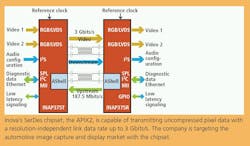Chipset maximizes video transfer rates for interfacing integrated vehicle cameras
According to Techno Systems Research (TSR; Tokyo, Japan), the percentage of integrated vehicle cameras using CMOS sensors is projected to increase from around 20% in 2008 to more than 70% in 2013.
However, rather than use existing computer-based standards to interface these cameras to processors and displays within vehicles, CMOS camera vendors and system suppliers—especially in Germany—are taking a different approach, endorsing the APIX SerDes chipset from Inova Semiconductors (Munich, Germany) to perform this function.
After being first announced in 2007, the latest incarnation of the chipset, known as APIX2, is capable of transmitting uncompressed pixel data with a resolution-independent maximum achievable link data rate up to 3 Gbits/s (see figure below). Although the maximum data rate of the link is 3 Gbits/s downstream and 187.5 Mbits/s upstream, the proprietary coding used in the device results in approximately 11% overhead, resulting in 2.6 Gbits/s net data rate that can be used for video.
Consisting of a transmitter and receiver, the INAP375T transmitter allows two independent RGB or LVDS channels, audio data, and control data to be transmitted at distances up to 12 m at 3 Gbits/s and up to 30 m at 500 Mbits/s depending on the physical layer settings and the cable characteristics. To carry both the 3-Gbit/s downstream data and 187.5-Mbit/s upstream data, the serial link typically requires two shielded twisted wire (STP) pairs. Thus, a single, four-wire STP copper cable can be used to interface both devices.
To allow secure and error-free data exchange across the bidirectional full-duplex APIX link, Inova has developed its APIX Automotive Shell (or AShell), an abstraction layer for image data communication. This abstraction layer can be implemented in both hardware and software as part of the APIX interface standard and is already supported by Fujitsu Semiconductors (Tokyo, Japan), Toshiba (Tokyo, Japan), Xilinx (San Jose, CA, USA), and Inova.
Inova has recently partnered with Supertech Optoelectronics (Taiwan) in the development of a digital camera module for remote automotive camera applications. The 30 × 30-mm camera module uses the APIX2 digital link technology and the high dynamic range (HDR) OV10630 sensor from OmniVision (Santa Clara, CA, USA) to connect the digital camera module with a receiving unit up to 10 m away. Using the APIX2 architecture, the imager can be controlled between single frames while images are continuously transmitted over the link. This minimizes the need for additional components such as microcontrollers or FPGAs in the camera.
Because the APIX2 uses its own clock based on integrated phase-locked loops (PLLs) in the serializer and deserializer, a dedicated and programmable clock output from the APIX2 can be used to generate the clock for the imager. Besides video transfer and full-duplex communication for camera control, the APIX2 standard can be used to supply power to devices that incorporate the interface.
To aid developers wishing to evaluate the APIX2 chipset, Inova has also developed a number of evaluation boards. One of these, a two-board demonstration kit consisting of a transmitter and receiver board, is designed to transmit image data over the interface. In operation, the transmitter board is used to capture data from two high-definition multimedia interface (HDMI) channels using two 12-bit ADV7614 receivers from Analog Devices (Norwood, MA, USA). Data are then transmitted over the APIX2 interface to a receiver board that outputs the data on two LVDS channels.
-- By Andrew Wilson, Vision Systems Design
